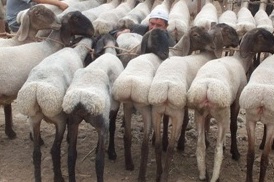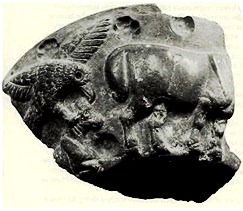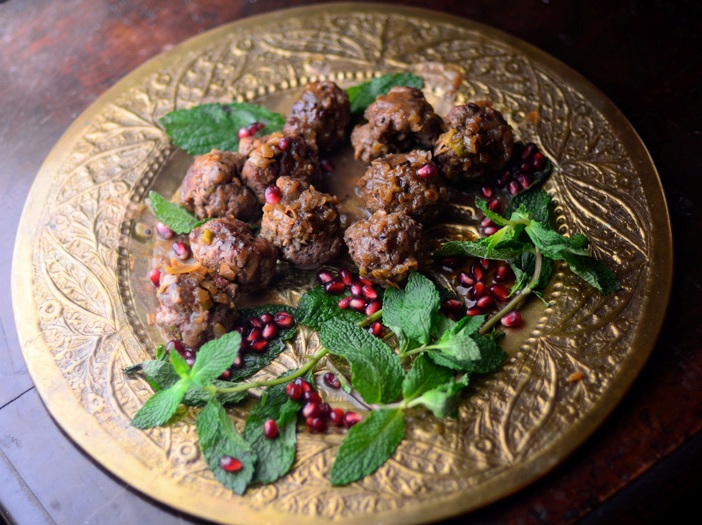Today we are treated to another guest post by the brilliant Deana Sidney from the site Lost Past Remembered. Deana is a professional designer by day and an avid food historian and accomplished cook all the time. She writes:
 Whenever I see the word Baghdad, a small door in my brain opens to a storybook world where perfumed silks billow over marble floors, scimitars flash and veiled woman have black-lined eyes and perfect beauty.
Whenever I see the word Baghdad, a small door in my brain opens to a storybook world where perfumed silks billow over marble floors, scimitars flash and veiled woman have black-lined eyes and perfect beauty.
I guess it’s pretty obvious the visuals for the stories in One Thousand and One Nights made a big impression on me as a child when I saw them in Maxfield Parrish’s illustrations for Arabian Nights and in Michael Powell’s Technicolor masterpiece, The Thief of Baghdad –– the images enchant all these years later. The idea of Baghdad is still tremendously alluring. Now it has a flavor too!
I know –– the truth of Baghdad today is a world of different. But I am going to go back in time to the golden age of Baghdad. The one thing that hasn’t changed is food … it is and was spectacular.
Kitab al-Ṭabīḫ (The Book of Dishes) was written by Muhammad bin Hasan al-Baghdadi in 1226, at the end of the golden age of the Abbasid Caliphate (an end brought about by the Mongol hoards that destroyed Baghdad in 1258). The Abbasid were incredibly sophisticated and inclusive of many other cultures, including Chinese as well as Persian and Turkish. The Caliphate reached the height of its powers in the 9th century when it stretched all through the Mediterranean to the Arabian Sea. Math, science and literature flourished. One of my favorite books, One Thousand and One Nights, was written during this time … combining tales of many cultures and giving us Aladdin, Sinbad and Ali Baba. There really was a world like the one in my imagination –– once upon a time.
 The cookbook was a huge hit and became famous, especially in Turkey where a copy ended up … remarkable since all copies were written by hand. There were originally 160 recipes that were expanded to 260 through the centuries.
The cookbook was a huge hit and became famous, especially in Turkey where a copy ended up … remarkable since all copies were written by hand. There were originally 160 recipes that were expanded to 260 through the centuries.
I found the book quite by accident, intrigued by an online recipe about the addictive salted sauce called murri that came from a translation of a recipe by Charles Perry (I wrote about murri HERE). That discovery compelled me to get a copy of A Baghdad Cookery Book. Once I opened it, I began cooking my way through it.
I had the good fortune to meet Mr. Perry at the Oxford Food Symposium. He has translated many manuscripts in many languages in addition to being a former LA Times food critic and Rolling Stone writer… what an interesting life he’s led! He was accessible and terribly nice.
 When I went out to LA for the Lambapalooza dinner (that I wrote about HERE), I couldn’t think of a better companion for the meal than Mr. Perry since I made his recipe for Rutabiyya as my offering for the feast. He walked me through preparation of the classic murri and with his help I made another version by rotting barley for weeks! I shared samples of ambergris and manna that I had procured for the dinner with him as a small thank you for his help.
When I went out to LA for the Lambapalooza dinner (that I wrote about HERE), I couldn’t think of a better companion for the meal than Mr. Perry since I made his recipe for Rutabiyya as my offering for the feast. He walked me through preparation of the classic murri and with his help I made another version by rotting barley for weeks! I shared samples of ambergris and manna that I had procured for the dinner with him as a small thank you for his help.
The recipe I am sharing today is called Mudaqqaqat Hamida (which means sour meatballs). I have been on a meatball roll lately (so to speak)… they are all the rage in NYC this year and perfect food for a cold winters night. This recipe is slightly exotic, but easy to make. They are like proto-Swedish meatballs since they are sweet and sour from the natural sweetness of the reduced stock and the lemon, sumac and pomegranate molasses.
 One ingredient that I do not use is something called tail fat. It comes from the fat-tailed sheep that I read makes up an astounding 25% of the world’s sheep population. I hear it may be available in the US but would be very difficult to come by. Almost every recipe in the book calls for using it. Absent tail fat, I would say using an animal fat like lard or duck fat would be similar to add extra flavor. A vegetable oil will be fine if you are squeamish about animal fat.
One ingredient that I do not use is something called tail fat. It comes from the fat-tailed sheep that I read makes up an astounding 25% of the world’s sheep population. I hear it may be available in the US but would be very difficult to come by. Almost every recipe in the book calls for using it. Absent tail fat, I would say using an animal fat like lard or duck fat would be similar to add extra flavor. A vegetable oil will be fine if you are squeamish about animal fat.
I know that mastic is not on every pantry shelf –– it is available online and in most Middle-Eastern markets and looks like a rough yellow diamond (it is a dried resin). You need very little. I learned that the hard way the first time I used it. The amount for the dish wasn’t really listed so I put in too much because I love the way it smelled –– it’s best when it is delicately used, then it’s lovely and haunting. Honestly, there is nothing that remotely tastes like it so I couldn’t think of making a substitution. The closest thing would be a splash of Retsina… but that wouldn’t be quite right. Sumac is also unusual, but is also available in those markets and online –– use extra lemon if you don’t have it. The meat has a wonderful sweetness to it and contrasts beautifully with the sour sauce. As with most dishes that have lots of warm spices, it perfumes your mouth when you eat it and is deeply satisfying. Serve with any flatbread or whole-wheat couscous.

Mudaqqaqat Hamida (sour meatballs) serves 4
Ingredients
1 pound ground lamb
1 t ground coriander
1 t ground pepper
1 t ground cinnamon
¼ t ground mastic (use a mortar and pestle, or roll it between foil with a rolling pin)
2/3 c chickpeas, mashed
2 small onions chopped
2 t salt or to taste
oil to brown meat
juice of 1 lemon
1 t sumac (optional)
½ t saffron threads
3 T pomegranate molasses
¼ to ½ cup chopped fresh mint (to your taste)
3 cups unsalted stock
1 – 2 drops Aftelier Rose Chef’s Essence or 2-3 T rosewater – to taste
Seeds from 1 pomegranate
Directions
Combine the lamb and spices and chickpeas and 1 onion. Roll into balls… small golf ball size is good. Brown in the fat with the rest of the onion and pour off any excess fat.
Add stock or water and lemon juice, sumac, saffron and cook the meatballs till they are done over a medium flame.
Reduce the liquid till it thickens somewhat. Add pomegranate molasses and rose essence/rosewater to taste and cook for another few minutes. The natural sweetness of the reduced stock is perfect with the sour additions. If you don’t reduce the sauce the sourness is unbalanced. Toss in some of the chopped mint and stir. Serve with Pomegranate seeds and fresh mint sprinkled on top.
Original recipe:
“Cut red meat into thin slices, then mince fine, adding seasonings, coriander, pepper, cinnamon and mastic together with chickpeas and a little onion. Made into kabobs, smaller than oranges. Melt fresh tail [fat], and throw in the kabobs, stirring until browned then cover with water. Cut up two or three onions and add. When cooked, removed the oils and sprinkle on top a little lemon or grape-juice, or a mixture of both, or sumac-juice, or pomegranate-juice. Rub over the saucepan some sprigs of dry mint, and throw in a little mastic, pepper and cinnamon. If desired, sprinkle in a little wine-vinegar, and color with saffron. Spray the saucepan with a little rose-water, and wipe the sides with a clean rag. Leave over the fire and hour: then remove.”
__________
Thanks Deana for another amazing historical food adventure! (Words and photograph of Mudaqqaqat Hamida by Deana Sidney. Illustration of The Thief of Baghdad 1 & 2 by Maxfield Parrish from Wikipedia; illustration from 1429 edition of 1001 Nights from Answers.com; Book of Dishes from the Yale Library; photo of fat-tailed sheep from Wikipedia; and photo of stone bowl from Uruk from FAO.


1 thought on “Old Baghdad and Fragrant Lamb Meatballs with Sour Sauce”